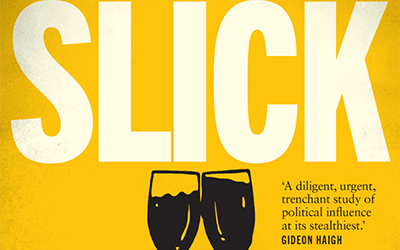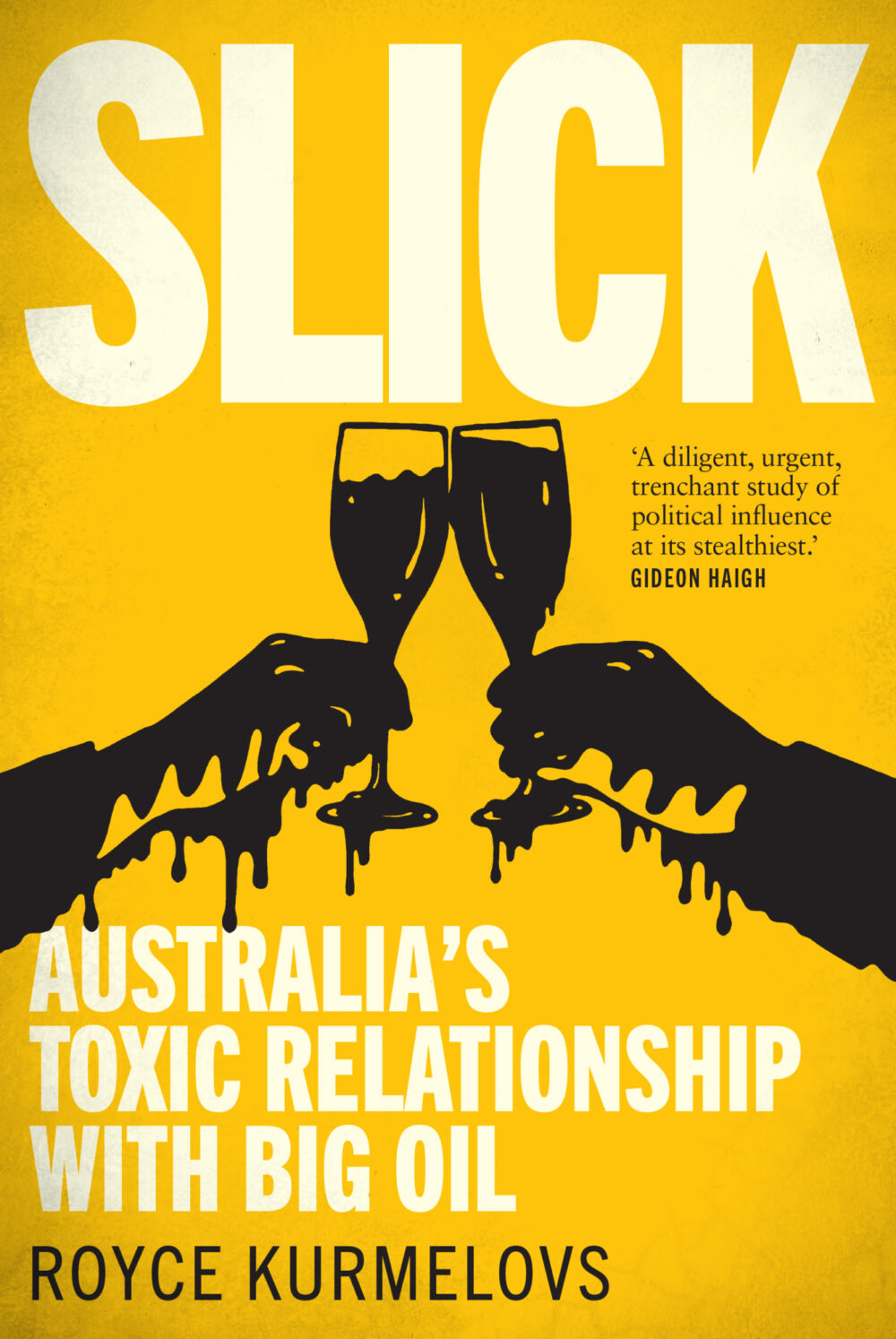
- Free Article: No
- Contents Category: Business
- Review Article: Yes
- Article Title: ‘Together We Shine’
- Article Subtitle: How business, politics, and science interconnect
- Online Only: Yes
- Custom Highlight Text:
Journalist Royce Kurmelovs has written several business-focused books, including a well-received account of the end of Australia’s iconic Holden cars (The Death of Holden, 2016) and a partly personal analysis of the social costs of ubiquitous indebtedness (Just Money, 2020).
- Featured Image (400px * 250px):

- Alt Tag (Featured Image): Stuart Kells reviews ‘Slick: Australia’s toxic relationship with big oil’ by Royce Kurmelovs
- Book 1 Title: Slick
- Book 1 Subtitle: Australia’s toxic relationship with big oil
- Book 1 Biblio: University of Queensland Press, $34.99 pb, 342 pp
- Book 1 Cover Small (400 x 600):

- Book 1 Cover (800 x 1200):

- Book 1 Readings Link: https://www.readings.com.au/product/9780702268601/slick--royce-kurmelovs--2024--9780702268601#rac:jokjjzr6ly9m
In 1959, for example, Edward Teller told a major symposium in New York that carbon dioxide in the atmosphere was ‘a serious additional impediment for [heat] radiation leaving the earth’. Teller had helped develop the atom bomb and, Kurmelovs writes, ‘later denounced J. Robert Oppenheimer as a communist’. The atmospheric heating, Teller said, could cause the ice caps to melt and the oceans to rise. ‘I don’t know whether they will cover the Empire State Building,’ he said, ‘but anyone can calculate it by looking at the map and noting that the ice caps over Greenland and over Antarctica are perhaps five thousand feet thick’.
A decade after Teller’s warning, Harry Bloom, a professor of chemistry at the University of Tasmania, told an Australian parliamentary committee that the build-up of carbon dioxide in the atmosphere could trap solar radiation and, in words that echoed Teller’s, ‘cause climatic conditions to change all over the world, perhaps heating the whole world and melting the ice caps’.
Equipped with this knowledge, Australia’s oilmen joined the global effort to oppose and undermine sensible limits to the burning of fossil fuels. Central to Kurmelovs’ thesis is the idea of state capture by the oil and gas industry. By building strong and pervasive links with governments and public agencies and research bodies, the oilmen were able to shape policy and extract subsidies and other protections. They used misinformation and other tactics (including sponsorship of arts organisations such as the Perth Festival and the Western Australian Youth Orchestra) to shift public opinion and reduce confidence in the scientific evidence for climate change and its causes.
To tell this shocking and damning story, Kurmelovs describes the growth of Australia’s lucrative oil and gas industry. The beginnings were unpromising: even though an oily residue had contaminated colonial-era water wells, ‘Australia was originally considered too old for oil. According to the best geological thinking of the time, the sprawling, ancient continent didn’t have the right rocks’.
A series of exploration wells eventually overturned that thinking, and businesses rushed to exploit the newly discovered resources. Local entrepreneurs joined with American outfits such as Chevron, Texaco, and Caltex (aka the California Texas Oil Company).
In outlining the turbulent history of Australian oil and gas, the author weaves together a succession of familiar vignettes: the Khemlani loans affair, the Noonkanbah mining dispute, the flawed UN ‘COP’ process, Extinction Rebellion protests, and the blue hydrogen hoax. He also finds analogies in the history of tobacco regulation, and he brings to life the consequences of climate change with accounts of the Lismore floods, the Black Summer fires, and the sinking islands of the Pacific.
The characters in these pen portraits include climate victims, committed activists, frustrated academics, benighted whistleblowers, untroubled lobbyists, think-tank hacks, and Kurmelovs’ fellow journalists. The book also presents useful and authoritative histories of local oil and gas bodies such as the Australian Institute of Petroleum (AIP) and the Australian Petroleum Exploration Association (APEA), which became the Australian Petroleum Producers and Exploration Association (APPEA) and then Australian Energy Producers (AEP).
Kurmelovs, observant and sceptical, writes fresh, engaging prose. Along with his other works, Slick is part of a growing category of Australian books that look at the corporate world through a humane and progressive lens. Another marker of that category is the blending of serious content with pop-culture references, such as those to children’s television programs FernGully and Captain Planet. The venue for an oil industry gala in 2022 is, we are told, ‘like a scene from Blade Runner’. The words ‘Together We Shine’ are projected through ‘a blue haze on the main stage’. Those words refer, Kurmelovs points out, to the song ‘Shine’ by Vanessa Amorosi, a song that is strangely apposite for an oil and gas industry event as it was originally called ‘Die’ and includes lyrics such as ‘bang your head’, ‘lose your soul’, and ‘drown in a hole’. The entertainer at a 2023 APPEA conference is described as ‘a dreadlocked magician in a fedora who looked like a poor-man’s Criss Angel’. (The conference dinner entrée is ‘Eyre Peninsula oyster, finger lime caviar, KIS vodka and Geraldton wax-cured kingfish, prawn and blue swimmer crab rillettes, lemon and caper remoulade, native herb oil’.)
Slick is presented as a piece of investigative journalism that reveals ‘how power works in Australia’. Kurmelovs’ research is important and timely. While he offers a compelling mosaic, ultimately there is no smoking gun. The author could have done more to fully portray and penetrate the business-science-government nexus that has regularly derailed policy action on climate change in this country.
Industry lobbyists, oil and gas CEOs, household-name politicians, heads of Commonwealth agencies, and members of the Institute of Public Affairs feature prominently in Slick. If they have a view at all of the book, they may feel as though they have got off lightly. (There is no index for those figures to look themselves up.)
One of the dirty secrets of academia in Australia and elsewhere in the anglosphere is that a large proportion of published quantitative research is mathematically and methodologically bogus. In Slick, I would have liked to have seen more extensive exposure of sponsored and fraudulent research.
Kurmelovs could have done more to elucidate the contemporary reality of state capture and Big Oil, exemplified by the revolving door between politics, academia, business, and professional services such as Big Law and the Big Four; and how climate-change denial is part of the everyday interpersonal currency in networks that span corporations, exclusive clubs, the media, and even religious organisations.
I would also have liked to hear more about the origins of Australia’s natural resource companies, including their use of legal structures and frameworks adapted from the law of the sea. Kurmelovs, moreover, could have delved further into the public policy conundrums of greenhouse gas abatement, such as the risk that a garbled policy conversation and a mismanaged energy transition risks favouring equally obnoxious energy options, or even more obnoxious ones such as nuclear power.
As a result of these exclusions and elisions, the tale at the heart of Slick is unfinished. But as an excellent piece of journalism that makes a significant step towards a full accounting of how business, politics, and science really function in Australia, Kurmelovs’ work is to be commended.


Comments powered by CComment